 Nygren and friends teach moviegoers all about natural selection. 
We'll return to paperback covers tomorrow, but for the moment we're running with the same sort of material we posted a couple of days ago, because as the weather warms thoughts naturally turn to sensual pleasures. We can't think of a movie more sensual than Emmanuelle IV. Set in our planet's most sensual country, steamy Brazil, it was the entry in the Emmanuelle series that ushered original lead Sylvia Kristel out the studio gate, and brought in the first of several new Emmanuelles, in this case Swedish actress Mia Nygren. This West German poster, on which the film is titled Die orgien der Emmanuelle, or “the orgies of Emmanuelle,” caught our eye because—well, for several reasons—but mainly because Nygren is pushed into the background by Camella Donner, aka Camella Thomas. Why is that so interesting? Because she isn't in the cast. She probably wasn't even on the same continent. We guess the West German distributors wanted to sex up the poster a bit more. Donner would have been a great addition to the film, but even without her it was fun. Ridiculous, stupid, carnivalesque fun. They don't make 'em like that anymore. Emmanuelle IV premiered in West Germany today in 1984.
 It's the same old story. Take a trip to the tropics, lose every bit of self control. 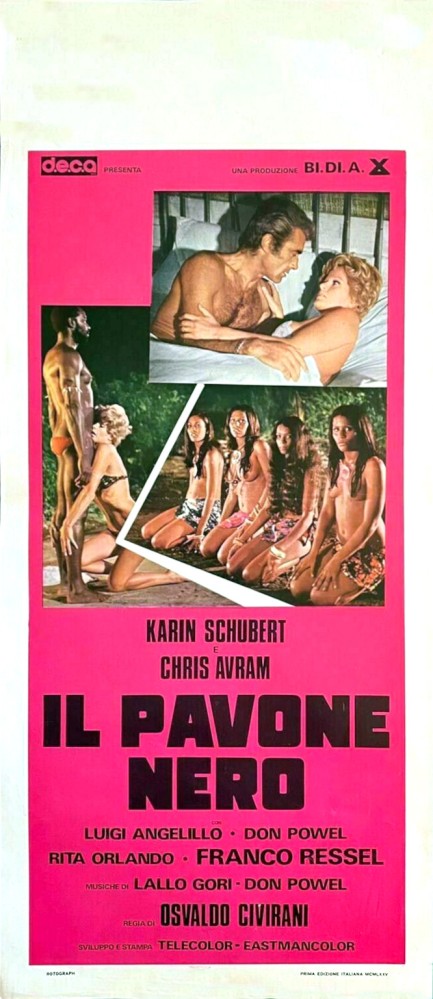
We ran across this Italian locandina for the shot-in-the-Dominican Republic sexploitation flick Il pavone nero, known in English as Voodoo Sexy, and thought it made a nice alternate promo to the one we posted years back. The movie premiered in Italy today in 1975, and with a title like Voodoo Sexy you know what it's about: white skin + tropical heat = a total loss of inhibitions. Flicks of this ilk were an unofficial subgenre of ’70s and ’80s cinema. We love them, and you know why? Because they aren't wildly inaccurate in terms of northerners going crazy down south. The star of this one was German actress Karin Schubert, and that's the other reason we revisited the film—it gave us an excuse to share the photo of her below. Hope it helps you get over hump day. 
 Thank you very much. Next I'd like to massacre a song by Joan Baez. 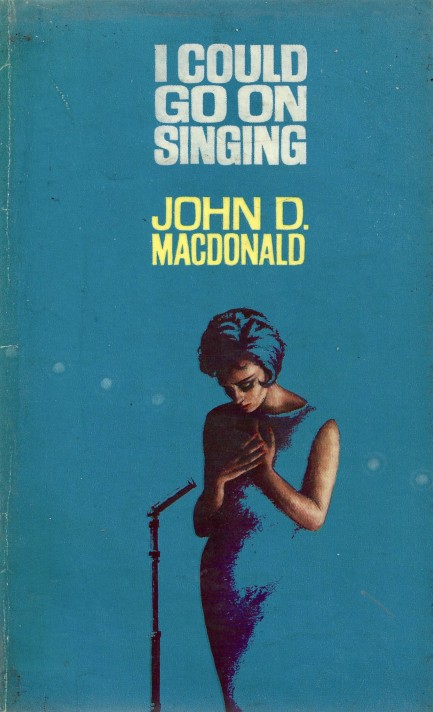
Since we took a look at Barbara Walton's cover work recently we thought we'd circle back to her with an effort for John D. MacDonald's I Could Go On Singing, originally published in 1963 with this Robert Hale Ltd. hardback coming in ’64. This is very different, very minimalist work from Walton compared to what we showed you last time, but it just demonstrates her broad range. It's different work for pop fiction icon MacDonald too, as it was a novelization for a 1963 movie of the same name. Hey, whatever pays the bills. We didn't read it, but we gather that he managed to put his unique stamp on it.
 Strange ideas from the minds and lenses of mid-century promo photographers. 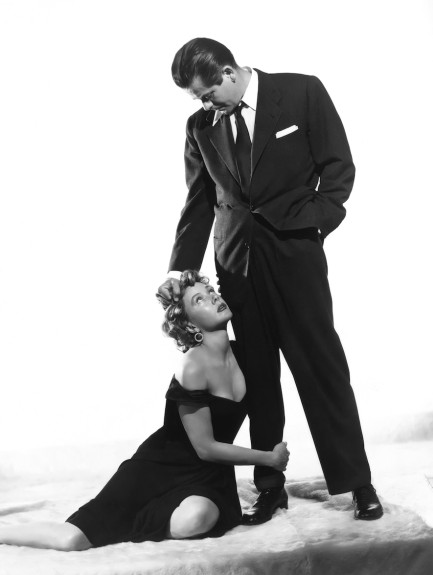 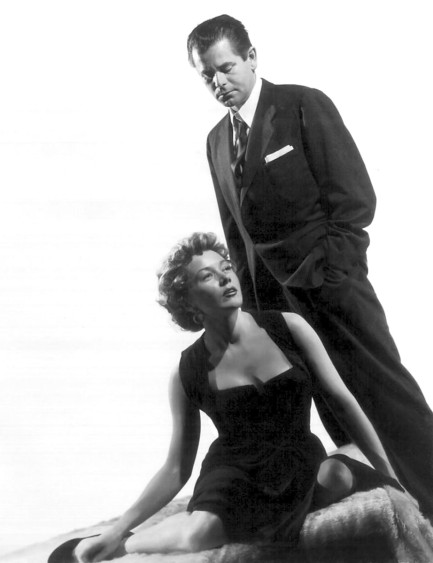 A while back we shared a promo photo of Glenn Ford and Gloria Grahame from 1953's The Big Heat that was meant to imply oral sex (it absolutely was, and you can see for yourself here). We commented on its weirdness, and noted that an actress would probably not be asked or made to pose that way today. The shot got us thinking about whether there were other kneeling promo shots from the mid-century era, and above you see two others from The Big Heat. Below we have more such shots, and while none are as jarring as that previous promo, they're all interesting. We assumed there would be few if any featuring kneeling males, but we found a couple. Even so, there are probably scores more kneeling actresses that we missed. While many of shots took the form they did to highlight the criminal/victim themes in their parent films, you still have to wonder what else—consciously or not—was in the various photograhers' minds. Anyway, just some food for thought this lovely Thursday. Ready, set discuss! 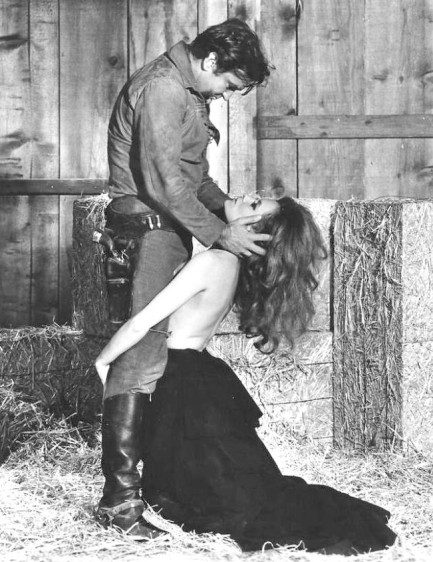 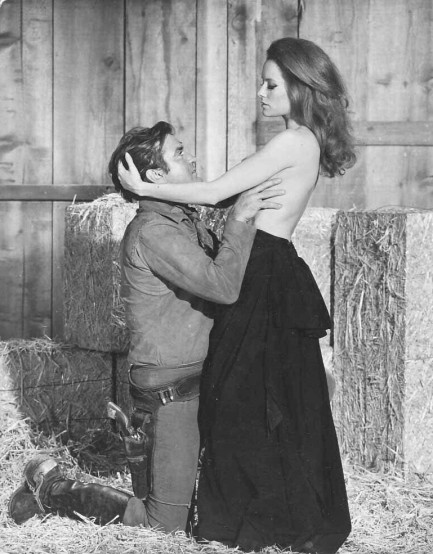 Rod Taylor and Luciana Pauluzzi swap subordinate positions for 1967's Chuka. Rod Taylor and Luciana Pauluzzi swap subordinate positions for 1967's Chuka.
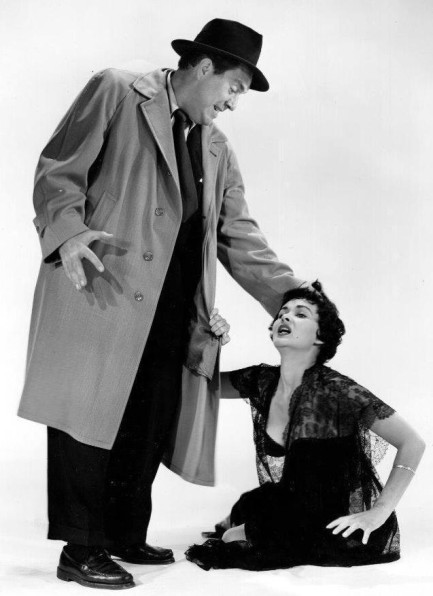 Edmund O'Brien goes for the time honored hair grab on Marla English for 1954's Shield for Murder. Edmund O'Brien goes for the time honored hair grab on Marla English for 1954's Shield for Murder.
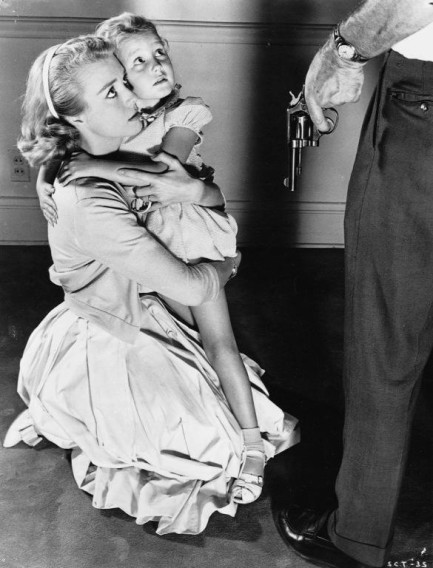 Inger Stevens and Terry Ann Ross for Cry Terror, an adaptation of a novel we talked about a few years ago. Inger Stevens and Terry Ann Ross for Cry Terror, an adaptation of a novel we talked about a few years ago.
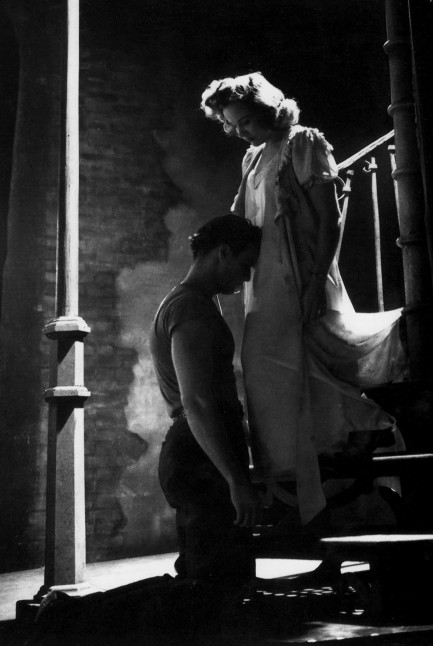 Kim Hunter soothes an overheated Marlon Brando in a promo for 1951's A Streetcar Named Desire. Kim Hunter soothes an overheated Marlon Brando in a promo for 1951's A Streetcar Named Desire.
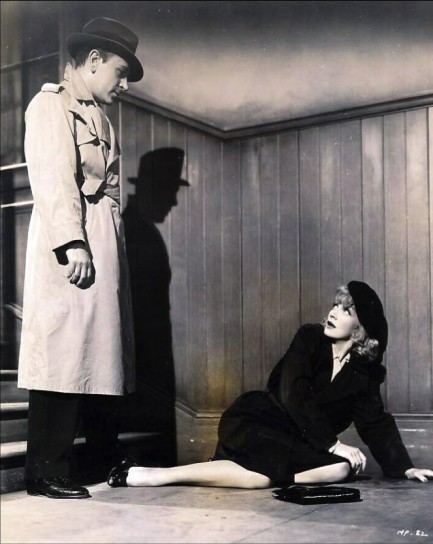 George Raft menaces Marlene Dietrich in the 1941 comedy Manpower. George Raft menaces Marlene Dietrich in the 1941 comedy Manpower.
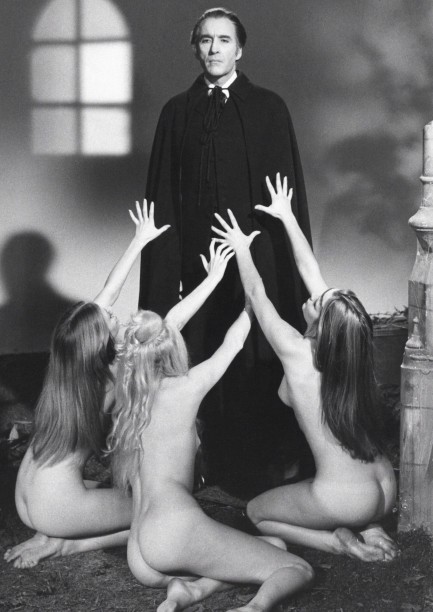 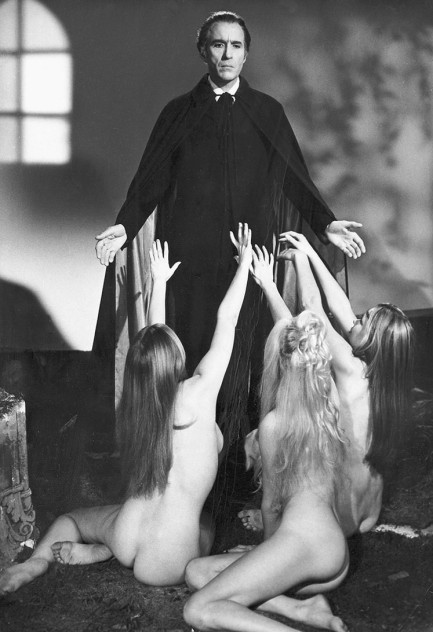 As promos go, these actually make sense. They show three unidentified models mesmerized by vampire Christopher Lee for 1970's Taste the Blood of Dracula. As promos go, these actually make sense. They show three unidentified models mesmerized by vampire Christopher Lee for 1970's Taste the Blood of Dracula.
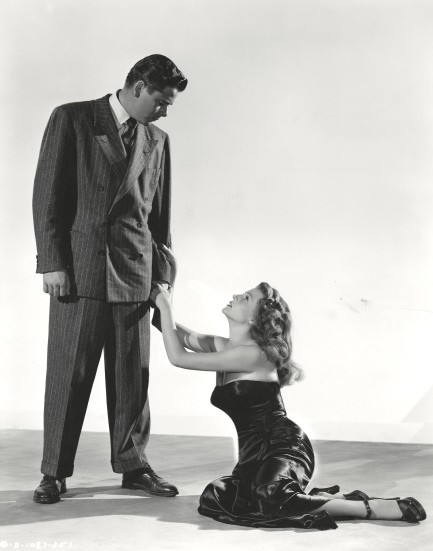 Glenn Ford is at it again, this time looming over Rita Hayworth for the 1946 classic Gilda. Glenn Ford is at it again, this time looming over Rita Hayworth for the 1946 classic Gilda. 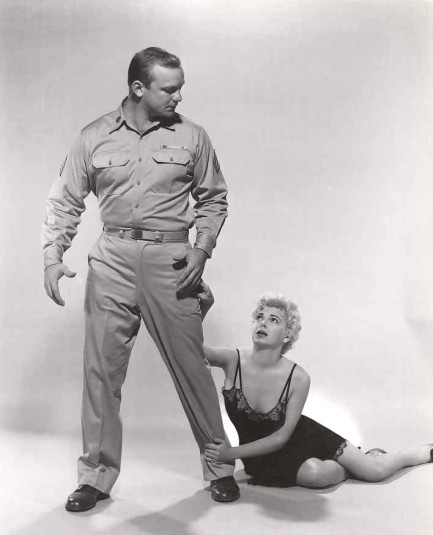 Aldo Ray and Barbara Nichols for 1958's The Naked and the Dead. Aldo Ray and Barbara Nichols for 1958's The Naked and the Dead.
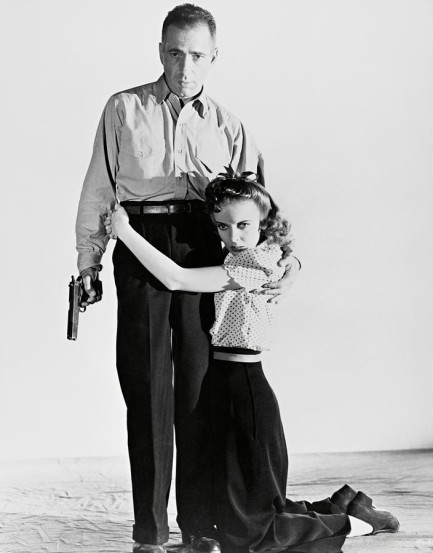 This one shows less domination and more protectiveness, as Humphrey Bogart prepares to defend Ida Lupino for High Sierra, 1941. This one shows less domination and more protectiveness, as Humphrey Bogart prepares to defend Ida Lupino for High Sierra, 1941.
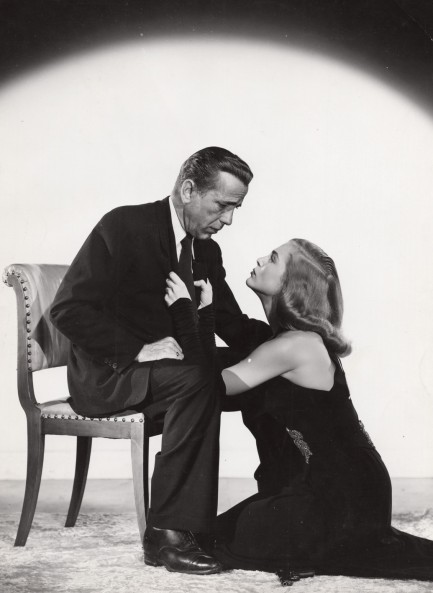 Humphrey once more. Here he's with Lizabeth Scott for Dead Reckoning, 1947. Humphrey once more. Here he's with Lizabeth Scott for Dead Reckoning, 1947.
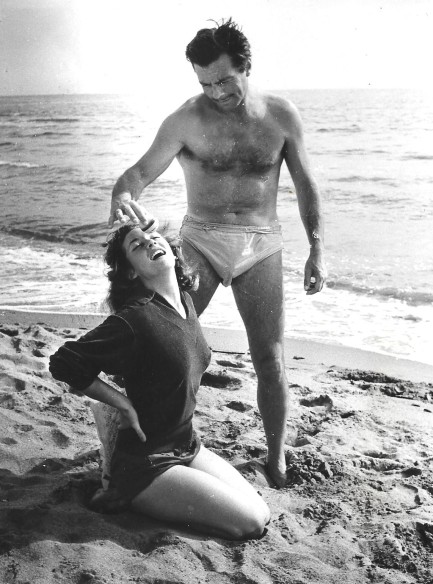 This shot shows Brazilian actress Fiorella Mari with an actor we can't identify in a movie we also can't identify. This shot shows Brazilian actress Fiorella Mari with an actor we can't identify in a movie we also can't identify.
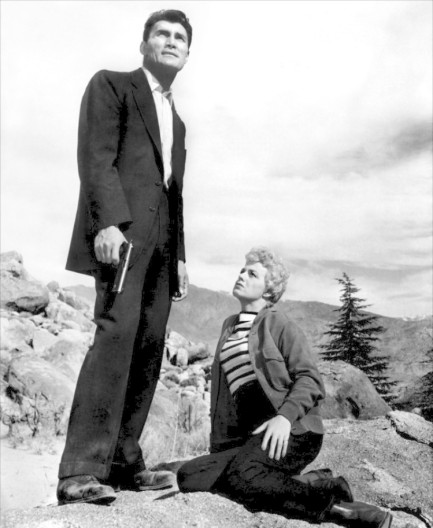 Shelly Winters and Jack Palance climb the highest mountain together for I Died a Thousand Times, 1955. Shelly Winters and Jack Palance climb the highest mountain together for I Died a Thousand Times, 1955.
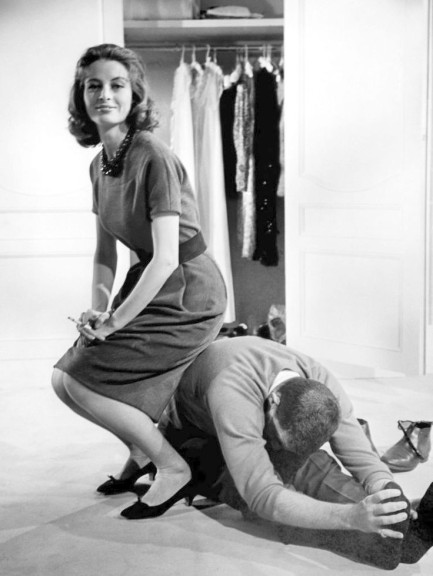 As we said, we didn't find as many examples of kneeling men, but we found this gem—Cappucine makes a seat of director Blake Edwards on the set of The Pink Panther in 1963. Does this count, though? While Edwards is subordinate, he isn't kneeling and it really isn’t a legit promo. As we said, we didn't find as many examples of kneeling men, but we found this gem—Cappucine makes a seat of director Blake Edwards on the set of The Pink Panther in 1963. Does this count, though? While Edwards is subordinate, he isn't kneeling and it really isn’t a legit promo.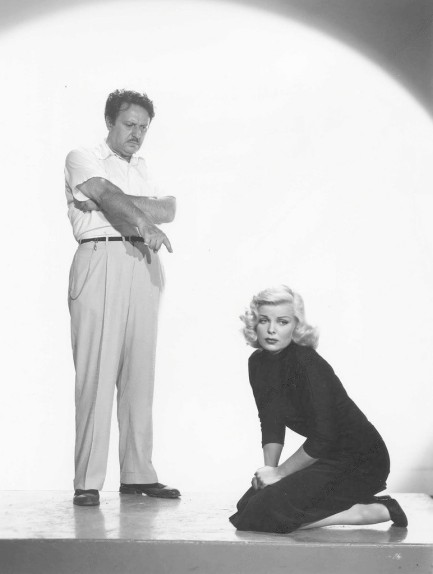 And lastly, in a curious example, Hugo Haas seems to tell Cleo Moore to stay in a shot made for 1953's One Girl's Confession. And lastly, in a curious example, Hugo Haas seems to tell Cleo Moore to stay in a shot made for 1953's One Girl's Confession.
 I chose the stage name Busty, but I think you'll agree I have other assets. 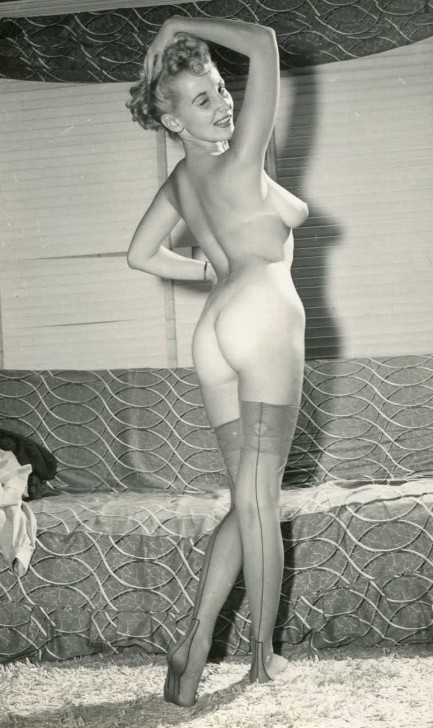
Here's a nice photo of U.S. burlesque star Donna Mae Brown, aka Busty Brown. We had some fun with a 1960 photo of her in divorce court, but wanted to bring her back. Old photos of burlesque performers are often hard to date, but Brown was very popular for most of the 1950s, so if you split the difference this shot might have been made around 1955.
 How does an angel get its wings? Via cleverly repurposed cover art. 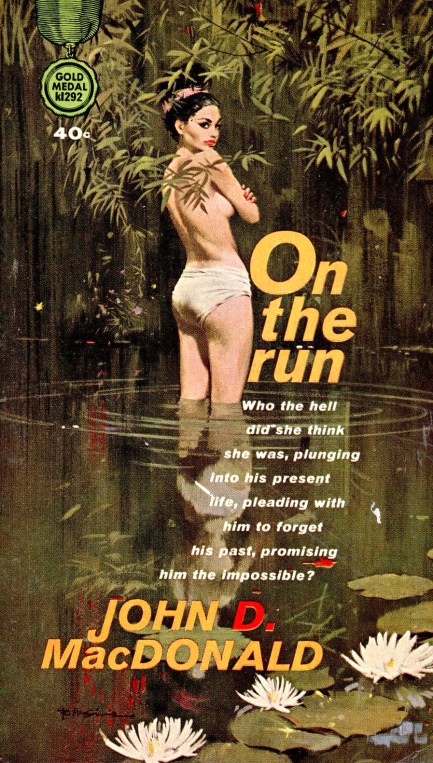 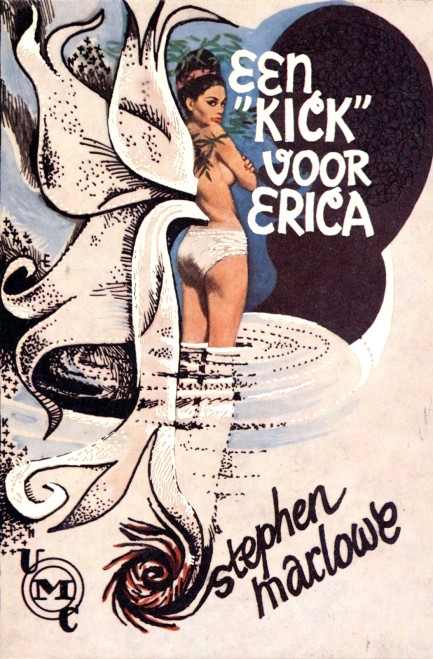
European and Australian publishers made a habit of reusing U.S. paperback art, and you see another example above. The top piece for John D. MacDonald's 1963 novel On the Run received a remix on the front of 1968's Een “kick” voor Erica, which is a translation by Dutch publishers Combinatie of Stephen Marlowe's 1967 novel Drumbeat — Erica. It's hard to improve on a McGinnis, but we think the fantasy-like transformation and giant wings—dare we say?—elevate cover number one to something even nicer. We found both on Flickr, so thanks to those two uploaders.
 I want to remember everything about this experience. For starters tell me your name. 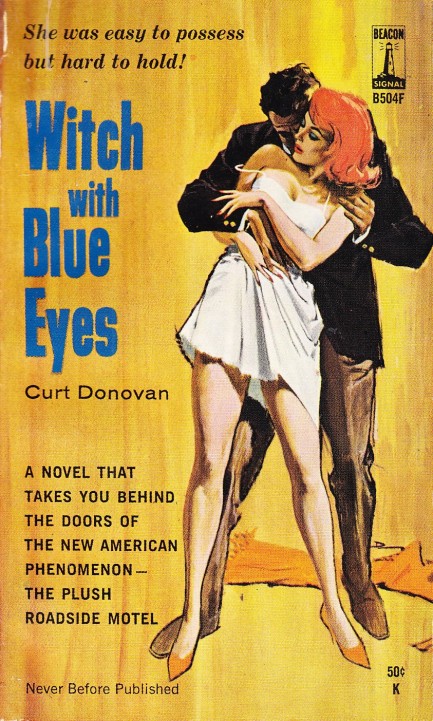
The 1962 novel Witch with Blue Eyes, which you see here with its Ernest Chiriacka cover art, is about a man who quits a big hotel operation, hires on as manager of the Snug Haven roadside motel, but must battle two craven partners in order to turn it from a shady dive into a respectable success. The hours and stress test his marriage to the owner's daughter, and problems worsen when his former lover—the eponymous witch with blue eyes—arrives on the scene (accompanied by her evil cat Big Bad) to ruin him. The book was presented by publishers Beacon-Signal as sleaze, but it's virtually sexless, and as a pure drama it's flatter than a flapjack. We suggest you don't check in to this motel.
 Caffaro knows how to Handle her business. 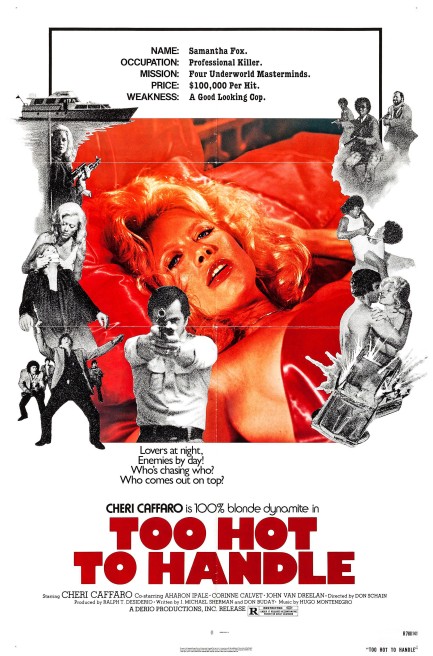
Why do we spend our valuable time watching exploitation movies? Well, because we watch all pulp related genres of movies, from film noir to horror. So why discriminate? We also watch such movies (which is a set we figure includes sexploitation, blaxploitation, women-in-prison, and more) because owing to their sexual, racial, and political aspects, their like will probably never be made again. Last month we completed our look at Cheri Caffaro's infamous Ginger McAllister sexploitation-spy trilogy. Now we're moving on to her later work in Too Hot To Handle, which premiered today in 1977.
Set in and around Manila, Caffaro plays an experienced and wealthy assassin named Samantha Fox who takes on a difficult triple-contract. In order to succeed she'll need all her skills of disguise, deception, and sexuality. Meanwhile the cops are on her trail. When one of the investigators gets close—real close—Caffaro takes a liking to him and, passing herself off as her alter ego Melinda Burroughs, tries to navigate sleeping with the enemy while fulfilling her murderous obligations.
All Caffaro movies are low budget, and all are bad. This one is poorly written and acted, and as usual there's a touch of the kinky, both in front of the camera, as well as behind, as Caffaro's husband Don Schain directs her getting her squeezebox fondled by hairy co-star Aharon Ipalé. That's called commitment to the product and your art—or alternatively, finding a way to monetize your spouse-sharing fantasies. It didn't improve the movie.
The only surprise here was that former top European star Corinne Calvet somehow got suckered into playing a brothel owner named Madame Ruanda, later dying as one of Caffaro's targets. Alas, Corinne—sexploitation is a welcoming mistress for those desperate to pay bills, but next time we recommend a loan shark. The vig is a bitch but at least you get to hang onto your dignity. But even if Too Hot To Handle was too bad for Calvet to be in, it isn't too bad for you to watch. Caffaro is weirdly great. In the sexploitation realm nobody did more with less.
 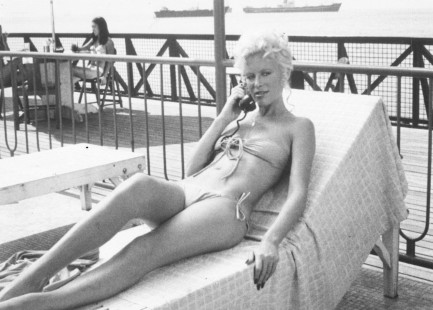 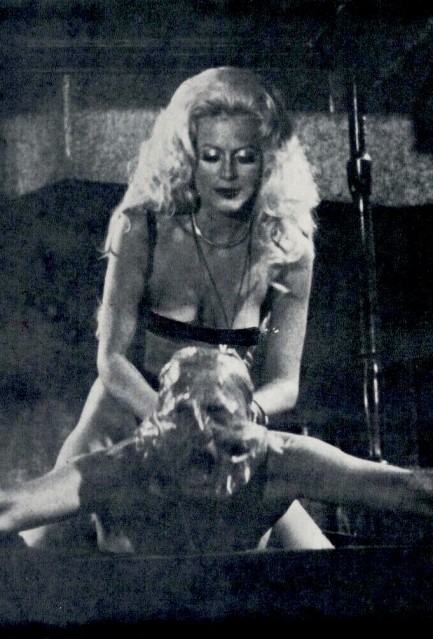 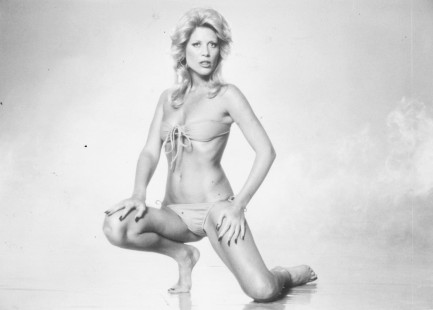
 Me? Why should I touch it? You’re the one always going on about how you can tell everything about a man from his handshake. 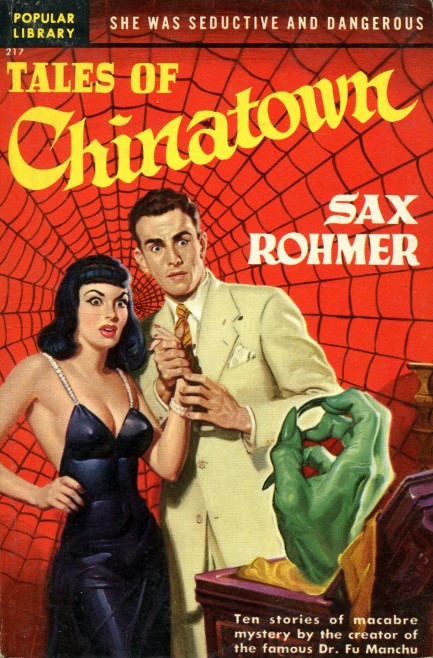
British author Sax Rohmer, aka Arthur Henry Ward, wrote many novels but made his reputation with the Fu Manchu series. Tales of Chinatown doesn’t feature that famous character, but instead deals in short story form with other characters and various unsavory goings-on in the Chinese underworld of London’s Limehouse district. There are problems with Rohmer’s depictions of Chinese, Jews, and other groups, but the writing is more than a century old, so no surprise there.
In terms of execution, there’s a sinister mood of a type here that's quite effective. "The Daughter of Huang Chow," the opening tale, deals with a series of fatal poisonings among the Limehouse criminal set, and the mysterious contents of an ornamental coffin. "The Hand of the Mandarin Quong," from which the cover is derived, is set in Singapore and London, and tells the story of a man who loses a hand in a failed attempt to rescue his kidnapped wife, but whose severed body part continues to haunt and hunt the kidnapper.
Tales of Chinatown is an atmospheric collection, well written and imaginatively conceived. It's easy to see why Rohmer became an international sensation. Many of his tropes are by now familiar if not hackneyed (and his racialized musings are deservingly excoriated), but back when his ideas were fresh they must have given his readers the megacreeps. Crime, suspense, mystery, mysticism, horror—Tales of Chinatown has all that. It first appeared in 1922, and this Popular Library edition with art by Rudolph Belarski is from 1949.
 Rise by the camera, fall by the camera. 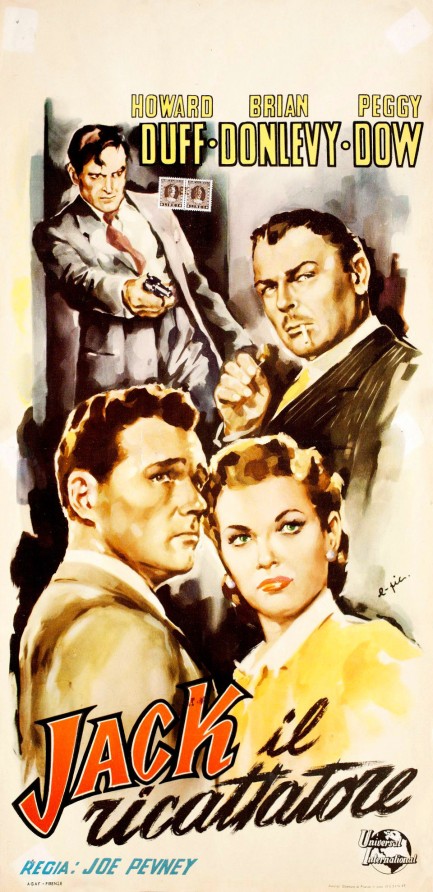
Above is a promo poster for the 1950 drama Shakedown made for the Italian market, where it was called Jack il ricattatore, or “Jack the blackmailer.” It stars Howard Duff as a photographer whose ambition pushes him across the line into criminality. We talked about it a while back. The poster is signed by an artist we can't identify—it looks like “e-pic.” We've seen other work by this person, but we don't have a real name or any other biographical info. This is a nice effort, so we'll an eye out.

|
 |

The headlines that mattered yesteryear.
1939—Batman Debuts
In Detective Comics #27, DC Comics publishes its second major superhero, Batman, who becomes one of the most popular comic book characters of all time, and then a popular camp television series starring Adam West, and lastly a multi-million dollar movie franchise starring Michael Keaton, then George Clooney, and finally Christian Bale. 1953—Crick and Watson Publish DNA Results
British scientists James D Watson and Francis Crick publish an article detailing their discovery of the existence and structure of deoxyribonucleic acid, or DNA, in Nature magazine. Their findings answer one of the oldest and most fundamental questions of biology, that of how living things reproduce themselves. 1967—First Space Program Casualty Occurs
Soviet cosmonaut Vladimir Komarov dies in Soyuz 1 when, during re-entry into Earth's atmosphere after more than ten successful orbits, the capsule's main parachute fails to deploy properly, and the backup chute becomes entangled in the first. The capsule's descent is slowed, but it still hits the ground at about 90 mph, at which point it bursts into flames. Komarov is the first human to die during a space mission. 1986—Otto Preminger Dies
Austro–Hungarian film director Otto Preminger, who directed such eternal classics as Laura, Anatomy of a Murder, Carmen Jones, The Man with the Golden Arm, and Stalag 17, and for his efforts earned a star on Hollywood's Walk of Fame, dies in New York City, aged 80, from cancer and Alzheimer's disease. 1998—James Earl Ray Dies
The convicted assassin of American civil rights leader Martin Luther King, Jr., petty criminal James Earl Ray, dies in prison of hepatitis aged 70, protesting his innocence as he had for decades. Members of the King family who supported Ray's fight to clear his name believed the U.S. Government had been involved in Dr. King's killing, but with Ray's death such questions became moot.
|

|
|

It's easy. We have an uploader that makes it a snap. Use it to submit your art, text, header, and subhead. Your post can be funny, serious, or anything in between, as long as it's vintage pulp. You'll get a byline and experience the fleeting pride of free authorship. We'll edit your post for typos, but the rest is up to you. Click here to give us your best shot.

|
|











 Rod Taylor and Luciana Pauluzzi swap subordinate positions for 1967's Chuka.
Rod Taylor and Luciana Pauluzzi swap subordinate positions for 1967's Chuka. Edmund O'Brien goes for the time honored hair grab on Marla English for 1954's Shield for Murder.
Edmund O'Brien goes for the time honored hair grab on Marla English for 1954's Shield for Murder. Marilyn Monroe swoons as Richard Widmark snarls for Don't Bother To Knock, 1952.
Marilyn Monroe swoons as Richard Widmark snarls for Don't Bother To Knock, 1952. Inger Stevens and Terry Ann Ross for Cry Terror, an adaptation of a novel we talked about a few years ago.
Inger Stevens and Terry Ann Ross for Cry Terror, an adaptation of a novel we talked about a few years ago. Kim Hunter soothes an overheated Marlon Brando in a promo for 1951's A Streetcar Named Desire.
Kim Hunter soothes an overheated Marlon Brando in a promo for 1951's A Streetcar Named Desire. George Raft menaces Marlene Dietrich in the 1941 comedy Manpower.
George Raft menaces Marlene Dietrich in the 1941 comedy Manpower.
 As promos go, these actually make sense. They show three unidentified models mesmerized by vampire Christopher Lee for 1970's Taste the Blood of Dracula.
As promos go, these actually make sense. They show three unidentified models mesmerized by vampire Christopher Lee for 1970's Taste the Blood of Dracula. Glenn Ford is at it again, this time looming over Rita Hayworth for the 1946 classic Gilda.
Glenn Ford is at it again, this time looming over Rita Hayworth for the 1946 classic Gilda. Aldo Ray and Barbara Nichols for 1958's The Naked and the Dead.
Aldo Ray and Barbara Nichols for 1958's The Naked and the Dead. This one shows less domination and more protectiveness, as Humphrey Bogart prepares to defend Ida Lupino for High Sierra, 1941.
This one shows less domination and more protectiveness, as Humphrey Bogart prepares to defend Ida Lupino for High Sierra, 1941. Humphrey once more. Here he's with Lizabeth Scott for Dead Reckoning, 1947.
Humphrey once more. Here he's with Lizabeth Scott for Dead Reckoning, 1947. This shot shows Brazilian actress Fiorella Mari with an actor we can't identify in a movie we also can't identify.
This shot shows Brazilian actress Fiorella Mari with an actor we can't identify in a movie we also can't identify. Shelly Winters and Jack Palance climb the highest mountain together for I Died a Thousand Times, 1955.
Shelly Winters and Jack Palance climb the highest mountain together for I Died a Thousand Times, 1955. As we said, we didn't find as many examples of kneeling men, but we found this gem—Cappucine makes a seat of director Blake Edwards on the set of The Pink Panther in 1963. Does this count, though? While Edwards is subordinate, he isn't kneeling and it really isn’t a legit promo.
As we said, we didn't find as many examples of kneeling men, but we found this gem—Cappucine makes a seat of director Blake Edwards on the set of The Pink Panther in 1963. Does this count, though? While Edwards is subordinate, he isn't kneeling and it really isn’t a legit promo. And lastly, in a curious example, Hugo Haas seems to tell Cleo Moore to stay in a shot made for 1953's One Girl's Confession.
And lastly, in a curious example, Hugo Haas seems to tell Cleo Moore to stay in a shot made for 1953's One Girl's Confession. 





















































































